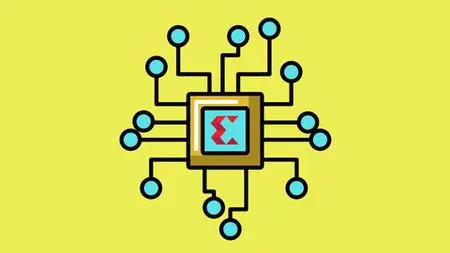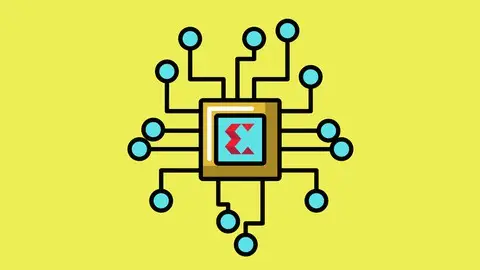Verilog For An Fpga Engineer With Xilinx Vivado Design Suite
Last updated 11/2022
MP4 | Video: h264, 1280x720 | Audio: AAC, 44.1 KHz
Language: English | Size: 4.75 GB | Duration: 16h 41m
Last updated 11/2022
MP4 | Video: h264, 1280x720 | Audio: AAC, 44.1 KHz
Language: English | Size: 4.75 GB | Duration: 16h 41m
Using Xilinx FPGA's
What you'll learn
Fundamentals of Verilog Programming that will help to ace RTL Engineer Job Interviews.
Understand Vivado Design Suite flow for Digital System Design.
Hardware Debugging in Vivado viz. Integrated Logic Analyzer, Virtual I/O.
Different Modelling Styles in Hardware Description Language.
How to use Xilinx IP's and create Custom IP's.
IP integrator Design flow of the Vivado.
Writing Verilog Test benches.
Design of some real world projects such as : PMOD DA4 DAC interface, Function Generator, Small Processor Architecture, UART Interface, PWM, BIST for Development boards and many more.
Common Interview Questions
Requirements
Fundamental of Digital Circuit will give an added advantages.
Description
FPGA's are everywhere with their presence in the diverse set of the domain is increasing day by day. The two most popular Hardware description languages are VHDL and Verilog each having its unique advantage over the other. The best part about both of them is once you know one of them you automatically understand the other and then the capabilities of both worlds can be used to build complex systems. The course focus on the Verilog language. The curriculum is framed by analyzing the most common skills required by most of the firms working in this domain. Most of the concepts are explained considering practical real examples to help to build logic. The course illustrates the usage of Modeling style, Blocking and Non-blocking assignments, Synthesizable FSM, Building Memories with Block and Distribute Memory resources, Vivado IP integrator, and Hardware debugging techniques such as ILA and VIO. The course explores FPGA Design flow with the Xilinx Vivado Design suite along with a discussion on implementation strategies to achieve desired performance. Numerous projects are illustrated in detail to understand the usage of the Verilog constructs to interface real peripheral devices to the FPGA. A separate section on writing Testebench and FPGA architecture further builds an understanding of the FPGA internal resources and steps to perform verification of the design.
Overview
Section 1: Installing Vivado
Lecture 1 Target
Lecture 2 How to download and Install Vivado IDE on PC
Lecture 3 Adding License File
Lecture 4 Xilinx Vivado Webpack LIC FILE
Lecture 5 Adding boards such as Nexys 4 DDR which are not available in the Vivado
Lecture 6 Board Files
Lecture 7 Common Error with Vivado: Incorrect Microsoft Visual C++ redistributable package
Lecture 8 Cloud based IDE for learning Verilog constructs without Vivado
Section 2: Vivado Design Flow Part 1
Lecture 9 Target
Lecture 10 Creating New Project and adding Source File
Lecture 11 Adding Source Code
Lecture 12 Understanding Source Code
Lecture 13 RTL Schematic P1
Lecture 14 RTL Schematic P2
Lecture 15 Behavioral Simulation : Force Constant
Lecture 16 Behavioral Simulation : Force Clock
Lecture 17 Typical Testbench
Lecture 18 Synthesis P1
Lecture 19 Synthesis P2
Lecture 20 Implementation
Lecture 21 Generating Programming File
Lecture 22 Vivado GUI Insight
Lecture 23 Code for next Video
Lecture 24 Useful Simulation Options
Lecture 25 Simulation Multibit ports P1
Lecture 26 Simulation Multibit ports P2
Lecture 27 Use of RTL View in Vivado
Lecture 28 Use of Post Synthesis View in Vivado
Section 3: Vivado Design Flow Part 2
Lecture 29 Target
Lecture 30 Project Types in Vivado
Lecture 31 Understanding I/O Planning Project
Lecture 32 Types of Project and their meaning in Vivado
Lecture 33 Understanding Synthesis Settings
Lecture 34 Clock Gating in Synthesis
Lecture 35 FSM Encoding
Lecture 36 Fundamentals of FSM Encoding
Lecture 37 Vivado Pre-configured Synthesis Strategies
Lecture 38 Implementation Strategies Demonstration in Vivado
Lecture 39 Code
Lecture 40 FPGA Design Flow
Lecture 41 References for further study
Lecture 42 Complete FPGA Design Flow Demonstration
Lecture 43 Code Used in the Demonstration
Lecture 44 Incorrect Sim waveform in Post Synthesis and Post Implementation Testbench
Lecture 45 Understanding Folder hierarchy of Vivado
Section 4: Commonly Asked Question's from previous Module
Lecture 46 Q1
Lecture 47 Q2
Section 5: Fundamentals of Verilog
Lecture 48 Target
Lecture 49 Identifiers
Lecture 50 Getting Started with reg and wire type
Lecture 51 Number Format
Lecture 52 Verilog Datatypes
Lecture 53 Reporting Mechanism P1
Lecture 54 Reporting Mechanism P2
Lecture 55 Demonstration Reporting Mechanism P1
Lecture 56 Demonstration Reporting Mechanism P2
Lecture 57 Code
Lecture 58 Datatypes Demonstration
Lecture 59 Code
Lecture 60 Verilog Operators P1
Lecture 61 Verilog Operators P2
Lecture 62 Verilog Operators P3
Lecture 63 Verilog Operators P4
Lecture 64 Code
Section 6: Commonly Asked Question's from previous Module
Lecture 65 Q1
Lecture 66 Q2
Lecture 67 Q3
Lecture 68 Q4
Lecture 69 Q5
Lecture 70 Q6
Lecture 71 Q7
Section 7: Modeling Styles
Lecture 72 Target
Lecture 73 Modeling Style P1
Lecture 74 Modeling Style P2
Lecture 75 Demonstration
Section 8: Assignment Operators in Verilog
Lecture 76 Target
Lecture 77 Procedural Assingment Vs Continuous Assingment
Lecture 78 Understanding Continuous Assignment
Lecture 79 Code
Lecture 80 Understanding Procedural Assignment Operator
Lecture 81 Code
Lecture 82 Differences in Continuous and Procedural Assignment Operators
Lecture 83 Demonstration
Lecture 84 Code
Lecture 85 Swapping of Variable values
Lecture 86 Code
Section 9: FAQ
Lecture 87 What happens if I declare blocking statements rather than NB in Sequential Ckt
Section 10: Behavioral Modeling Style
Lecture 88 Target
Lecture 89 Behavioral Modeling Skeleton
Lecture 90 Initial Block : Behavioral Modeling Constructs P1
Lecture 91 Always Block : Behavioral Modeling Constructs P2
Lecture 92 Blocking and Non-Blocking Assig. Operator : Behavioral Modeling Construct P3
Lecture 93 Demonstration
Lecture 94 Code
Lecture 95 IF ELSE skeleton
Lecture 96 2:1 Mux : Combinational Circuit P1
Lecture 97 Code
Lecture 98 4:1 Mux : Combinational Circuit P2
Lecture 99 Code
Lecture 100 Case Skeleton
Lecture 101 Binary to 7-Seg Converter
Lecture 102 Code
Lecture 103 Differences between IF ELSE and CASE
Lecture 104 Code
Lecture 105 Data Flipflop : Sequential Circuit P1
Lecture 106 D-Flipflop Code
Lecture 107 Up Counter : Sequential Circuit P2
Lecture 108 Counter Code
Lecture 109 Special Counter P1
Lecture 110 Special Counter P2
Section 11: Commonly Asked Question's from previous Module
Lecture 111 Q1
Lecture 112 Q2
Lecture 113 Q3
Section 12: Gate Level Modeling Style
Lecture 114 Target
Lecture 115 Half-adder : All nets defined
Lecture 116 Code
Lecture 117 Full-adder : Few Undefined nets
Lecture 118 Alternative Method
Section 13: Switch level Modeling Style
Lecture 119 Target
Lecture 120 Fundamentals
Lecture 121 Inverter
Lecture 122 Code
Lecture 123 NAND GATE
Lecture 124 Code
Lecture 125 AND Gate
Lecture 126 Code
Section 14: Structural Modeling Style
Lecture 127 Target
Lecture 128 Fundamentals P1
Lecture 129 Fundamentals P2
Lecture 130 Full adder
Lecture 131 Code
Lecture 132 4:1 Mux
Lecture 133 Code
Section 15: Schematic based Design Entry with IP integrator and Xilinx IP's
Lecture 134 Target
Lecture 135 How to create IP
Lecture 136 Create a BD with IP
Lecture 137 How to refresh IP repository
Lecture 138 How to Update IP Source Code
Lecture 139 Override GUI parameters
Lecture 140 Implementing 4-bit Shift Register
Lecture 141 Implementing 4-bit Ripple Carry Adder P1
Lecture 142 Implementing 4-bit Ripple Carry Adder P2
Lecture 143 Design of Digital Filters using IP integrator
Section 16: Memories
Lecture 144 Target
Lecture 145 Memory Fundamentals
Lecture 146 Understanding Memory Size
Lecture 147 Single Port RAM : GENERAL METHOD
Lecture 148 Code
Lecture 149 Single Port RAM : LANGUAGE TEMPLATE
Lecture 150 Single Port RAM : IP Method
Lecture 151 Single Port ROM
Lecture 152 Matlab Code
Lecture 153 COE File
Section 17: Commonly Asked Question's from previous Module
Lecture 154 Q1
Section 18: Finite State Machines
Lecture 155 Target
Lecture 156 FSM Fundamentals
Lecture 157 Moore FSM
Lecture 158 Mealy FSM
Lecture 159 FSM Implementation Methodology
Lecture 160 3-Process Methodology : Moore FSM
Lecture 161 Code
Lecture 162 2-Process Methodology : Moore FSM
Lecture 163 Code
Lecture 164 1-Process Methodology : Moore FSM
Lecture 165 Code
Lecture 166 3-Process Methodology : Mealy FSM
Lecture 167 2-Process Methodology : Mealy FSM
Lecture 168 Code
Lecture 169 1-Process Methodology : Mealy FSM
Lecture 170 Code
Lecture 171 Recommended Methodologies for FSM
Lecture 172 Synchronus Vs Asynchronus System
Lecture 173 Sequence Detector
Lecture 174 Overlapping Sequence Detector
Lecture 175 Non-Overlapping Sequence Detector
Lecture 176 Overlapping Sequence Detector
Lecture 177 Code
Lecture 178 Non-Overlapping Sequence Detector
Lecture 179 Code
Section 19: Commonly Asked Question's from previous Module
Lecture 180 Q1 ( Sourav Biswal )
Lecture 181 Q2 (Yashwant Kumar)
Lecture 182 Q3 (Apoorva Srivastava)
Section 20: Writing Testbenches
Lecture 183 Target
Lecture 184 Understanding Signals
Lecture 185 Generating Fixed Point Clock Period
Lecture 186 Generating Floating Point Clock Signals
Lecture 187 Demonstration
Lecture 188 Code
Lecture 189 Generating Reset Signal
Lecture 190 Generating Stimulus for Multibit Signals
Lecture 191 Understanding Task
Lecture 192 2:1 Mux
Lecture 193 Code
Lecture 194 Binary to Excess-3 Converter
Lecture 195 Code
Lecture 196 Data Flipflop
Lecture 197 Code
Lecture 198 Counter
Lecture 199 Code
Lecture 200 Single Port RAM
Lecture 201 Code
Section 21: Hardware Debugging with Vivado (Required Hardware)
Lecture 202 Target
Lecture 203 Integrated Logic Analyzer P1
Lecture 204 Integrated Logic Analyzer P2
Lecture 205 Integrated Logic Analyzer P3
Lecture 206 ILA with IP Integrator
Lecture 207 Virtual I/O (VIO) P1
Lecture 208 Virtual I/O (VIO) P2
Lecture 209 Virtual I/O (VIO) P3
Section 22: File I/O
Lecture 210 Target
Lecture 211 Accessing File
Lecture 212 Writing Data to File
Lecture 213 Code
Lecture 214 Reading Data from File
Lecture 215 Reading Multiple Columns from File
Lecture 216 Code
Lecture 217 Exampl 1 : Adder
Lecture 218 Code
Lecture 219 Example 2: RAM
Lecture 220 Code
Section 23: Projects
Lecture 221 Target
Lecture 222 Understanding UART Protocol
Lecture 223 Clock for desired Baud
Lecture 224 UART Transmitter
Lecture 225 UART Receiver
Lecture 226 UART TB
Lecture 227 Design Code
Lecture 228 TB Code
Lecture 229 Serial Peripheral Interface
Lecture 230 Code
Lecture 231 PWM
Lecture 232 Code
Lecture 233 LCD
Lecture 234 Code
Lecture 235 BIST for SW and LED
Lecture 236 Code
Lecture 237 I2C
Lecture 238 Code
Section 24: RTL for Synthesis
Lecture 239 Good Practices
Section 25: FPGA Architecture Fundamentals
Lecture 240 Target
Lecture 241 Need of Reprogrammable architecture
Lecture 242 PLD Classification
Lecture 243 Simulating Programmable Logic
Lecture 244 PROM Demonstration on NI Multisim IDE
Lecture 245 PAL and PLA
Lecture 246 SPLD and GAL
Lecture 247 Going through GAL datasheet : 16V8
Lecture 248 SPLD and GAL Summary
Lecture 249 Understanding CPLD architecture
Lecture 250 Introduction to FPGA Architecture
Lecture 251 Wide Multiplexer Usage
Lecture 252 Understanding Spartan 6 Architecture
Lecture 253 Spartan 6 FPGA Architecture Summary
Section 26: Commonly Asked Question's from previous Module
Lecture 254 How 6-input LUT implements 4:1 Mux ? (Amaresh Mandal)
Section 27: Interview Preparations
Lecture 255 Resume Format
Lecture 256 Common Interview Questions
Section 28: Next Step
Lecture 257 RTL Verification with SystemVerilog for Newbie
Lecture 258 RTL Verification with UVM for Newbie
VLSI Job Seeker/ Graduate student looking to pursue career as RTL Engineer/ Design Engineer/ Verification Engineer.,Anyone interested to learn Xilinx FPGA/ Vivado Design Suite/ Verilog Hardware Description Language,Anyone interested to start career in ASIC/ VLSI domain.



